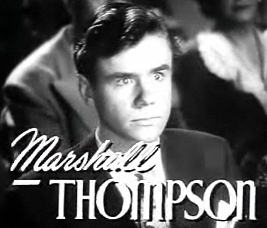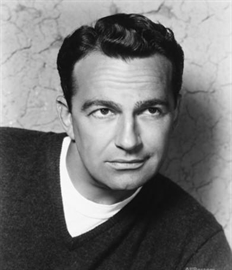
White Mischief is a 1987 British drama film starring Greta Scacchi, Charles Dance and Joss Ackland. It was directed by Michael Radford. The film was based upon the non-fiction book White Mischief: The Murder of Lord Erroll (1982), by James Fox, which originated from a newspaper article published in 1969.

James Marshall Thompson was an American film and television actor.

The Saint Meets the Tiger is a 1941 British mystery thriller film directed by Paul L. Stein and starring Hugh Sinclair, Jean Gillie and Clifford Evans. It was made by the British unit of RKO Pictures and released the same year, but was not distributed until 1943 in America. This was to be the last of the eight films in RKO's film series about the crimefighter the Saint. It was shot at Denham Studios outside London with sets designed by the art director Paul Sheriff. The previous entries in the series had all been made in Hollywood except The Saint's Vacation.

Robert Urquhart was a Scottish character actor who worked on the stage, for British television, and in film. His breakthrough role was Paul Krempe in The Curse of Frankenstein in 1957, along with Peter Cushing and Christopher Lee.

Perils of the Royal Mounted is a 1942 American Northern film. It was the 18th serial released by Columbia Pictures. It starred Robert Kellard as the hero, Sgt. Mack MacLane of the Royal Mounties, and Kenneth MacDonald as Mort Ramsome, the head villain. It also co-starred Nell O'Day, Iron Eyes Cody, Kermit Maynard and I. Stanford Jolley.

John Bentley was a British film actor. He had a successful career as a leading man from the 1940s to the late '50s and was a popular heart-throb who appeared in many British B-movies during that time. Later in his career, in the 1970s he appeared as Hugh Mortimer, Meg Richardson's ill-fated third husband in the English soap opera Crossroads. He also starred in the jungle adventure series African Patrol (1957) as Chief Inspector Paul Derek and made various other guest appearances in many popular TV series from the late 50s onwards.

Tarzan and the Amazons a 1945 American adventure film starring Johnny Weissmuller in his ninth outing as Tarzan. Brenda Joyce plays Jane, in the first of her five appearances in the role, and Johnny Sheffield makes his sixth appearance as Boy. Henry Stephenson and Maria Ouspenskaya co-star.

The Four Feathers is a 1929 American sound war film directed by Merian C. Cooper and starring William Powell, Richard Arlen, Clive Brook and Fay Wray. This was the third of numerous film versions of the 1902 novel The Four Feathers written by A. E. W. Mason. While the film has no audible dialog, it was released with a synchronized musical score with sound effects using both the sound-on-disc and sound-on-film process. The 1929 version of The Four Feathers premiered at the Criterion Theatre in New York City on June 12, 1929.

Tumbleweed is a 1953 American Western film directed by Nathan Juran and starring Audie Murphy, Lori Nelson, and Chill Wills. The film is based on the story "Three Were Renegades" by Kenneth Perkins, originally published in the December 1938 issue of Blue Book. IMDb and other sources mistakenly call the film a remake of the 1948 film Relentless, which was based on a similarly named story, "Three Were Thoroughbreds," by Perkins. The later story, "Three Were Renegades," was published as a sort-of sequel to the earlier story, "Three Were Thoroughbreds," and the plotlines of the two films mirror the plotlines of their respective source stories.

Fort Dodge Stampede is a 1951 Western film produced and directed by Harry Keller and starring Allan Lane. This film is one of 34 'B-movie' westerns filmed between 1947 and 1953 featuring Allan 'Rocky' Lane and his horse Black Jack.

The Golden Butterfly is a 1926 Austrian-German silent drama film directed by Michael Curtiz, and starring Hermann Leffler, Lili Damita, and Nils Asther. It was based on the 1915 short story "The Making of Mac's" by British author P. G. Wodehouse. The film was released in the United Kingdom as The Golden Butterfly, in a form shortened to 5 reels, and had a limited release in the US under the title The Road to Happiness.

Simba is a 1955 British war drama film directed by Brian Desmond Hurst, and starring Dirk Bogarde, Donald Sinden, Virginia McKenna, and Basil Sydney. The screenplay concerns a British family living in East Africa, who become embroiled in the Mau Mau Uprising.

George Paul Breakston was a French-American actor, producer and film director, active in Hollywood from his days as a child actor in Andy Hardy films in the 1930s, to a period as an independent producer/director in the 1950s.

The Royal African Rifles is a 1953 American Cinecolor First World War adventure film directed by Lesley Selander and starring Louis Hayward, Veronica Hurst and Michael Pate. It is set in British East Africa but filmed on location in the Los Angeles County Arboretum and Botanic Garden. The film was the first production of Louis Hayward's production company Associated Film Artists, but Hayward's company made no other films. It was distributed by Allied Artists. The working title was The Queen’s African Rifles. In reality, there was never a military unit called “The Royal African Rifles”, although the King's African Rifles served in Africa during the war. The film was retitled Storm Over Africa in the United Kingdom.

African Patrol is a 39-episode syndicated adventure television series created, directed and produced by George Breakston in conjunction with Jack J. Gross and Philip N. Krasne. It was filmed on location in Kenya for a period of 15 months beginning in January 1957.
The Girl from Alaska is a 1942 American Western film directed by Nick Grinde and William Witney and starring Ray Middleton, Jean Parker and Jerome Cowan. It follows a would-be prospector who becomes involved in a plot to steal from old prospector, but falls in love with his daughter instead.

Menace is a 1934 American mystery film directed by Ralph Murphy and starring Gertrude Michael, Paul Cavanagh and Henrietta Crosman. The emerging star Ray Milland billed fifth. It was produced and distributed by Paramount Pictures. It is based on the 1933 novel Menace by British writer Philip MacDonald. Mitchell Leisen was originally intended to direct the film before being replaced by Murphy. A review in the New York Times considered "it ranks several notches higher than the average murder film".

The Syndicate is a 1968 British film directed by Frederic Goode for Pathé Films, from a screenplay by Geoffrey Hays, based on the 1960 novel of the same name by Denys Rhodes. The film stars William Sylvester, June Ritchie, Robert Urquhart and Christian Doermer.

Men Against the Sun is a 1952 British historical adventure film directed by Brendan J. Stafford and starring John Bentley and Zena Marshall. It depicts the attempts to construct a railway in late Victorian Africa. It was shot on location in Kenya. This was unusually ambitious for a second feature film at the time.

Marcel Le Picard (1887–1952) was a French cinematographer known for his work on American films. He shot around two hundred films between 1916 and 1953. He did much of his prolific work for low-budget studios such as Republic Pictures, Monogram Pictures and Producers Releasing Corporation.



















